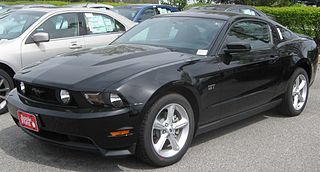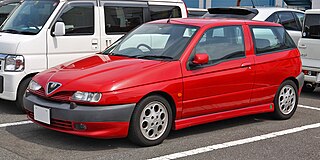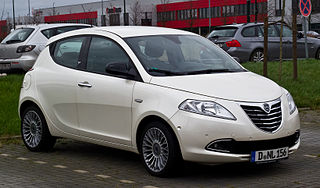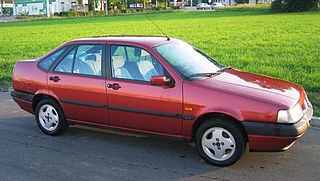
The Ford D2C platform is one of Ford's rear-wheel drive automobile platforms.

The Alfa Romeo 164 is a four-door executive saloon manufactured and marketed by Italian automaker Alfa Romeo from 1987-1998, styled by Pininfarina, and cooperatively designed and sharing platforms and numerous elements with the Fiat Croma, Saab 9000 and Lancia Thema.

A (semi) trailing-arm suspension, sometimes referred to as (semi) trailing-link is a vehicle axle or wheel suspension design in which one or more horizontal arms, perpendicular to and forward of the axle, are connecting the axle or wheels with pivot joint(s) ahead of them, on the structure of a motor vehicle. These are typically used on the rear axle or wheels of a vehicle, but also found in aircraft landing gear.

The Chapman strut is a design of independent rear suspension used for light cars, particularly sports and racing cars. It takes its name from, and is best known for its use by, Colin Chapman of Lotus.

A de Dion tube is a form of non-independent automobile suspension. It is a considerable improvement over the swing axle, Hotchkiss drive, or live axle. Because it plays no part in transmitting power to the drive wheels, it is sometimes called a "dead axle".

The Type Four chassis was a shared front wheel drive platform used in the 1980s and 1990s for the Saab 9000, Fiat Croma, Lancia Thema and Alfa Romeo 164.

The Alfa Romeo Brera and the Alfa Romeo Spider are mid-size sports cars using the GM/Fiat Premium platform, manufactured by Pininfarina and marketed by Alfa Romeo as a 2+2 coupé and roadster respectively.

The Alfa Romeo 145 and the Alfa Romeo 146 are small family cars produced by Italian automobile manufacturer Alfa Romeo between 1994 and 2000. The 145 is a three-door hatchback and was launched at the 1994 Turin Motor Show, while the 146 is a five-door hatchback, launched in 1995 to replace the Alfa Romeo 33.

The Lancia Beta was an entry-level luxury car produced by Italian car manufacturer Lancia from 1972 to 1984. It was the first new model introduced by Lancia after it had been taken over by Fiat in 1969.

The Alfa Romeo GTV and the Alfa Romeo Spider were sports cars produced by the Italian manufacturer Alfa Romeo from 1993 to 2004. The GTV is a 2+2 coupé, and the Spider is a two-seater roadster version of the GTV. Around 39,000 Spiders and 41,700 GTVs were built.

The Alfa Romeo GT is a coupe automobile that was produced by the Italian automaker Alfa Romeo between 2003 and 2010. The GT was introduced in March 2003 at the Geneva Motor Show. Production commenced on 28 November 2003, the GT was built at the Pomigliano plant, alongside the 147 and 159. A total of 80,832 units were produced.

The Lancia Ypsilon is a supermini manufactured and marketed by Lancia, now in its third generation and as of 2022, the marque's only model. The Ypsilon was released in 1995, as a larger and more expensive replacement to the Y10. Between 1995 and 2005, Lancia produced more than 870,000 Ypsilons in the Melfi plant in the Potenza region.

The Lancia Lybra is a compact executive car manufactured and marketed by Fiat's premium division, Lancia between 1998-2005, based on the Alfa Romeo 156 floorpan, and replacing the Dedra in Lancia's range. Like the Dedra, the Lybra was available as a Berlina (saloon) or a Station Wagon (estate). A total of 164.660 units were made.

The Alfa Romeo Protèo concept car was released at the Geneva Motor Show in 1991. It is a 2-door coupé cabriolet with folding roof, featuring a 3.0 liter quad-cam 24-valve, 60 degree V6 coupled with a 5-speed manual transmission, with a top speed of 250 km/h (155 mph). The engine used in Protèo produces 260 PS. The Protèo uses shortened floorpan used in Alfa Romeo 164 and features four wheel drive and steering. Many of the Protèo's design cues were influenced by the Alfa Romeo 916 series GTV/Spider, which was designed in July 1988. First design sketches by Alberto Bertelli are dated for December 1989. The name Protèo is derived from a Greek deity Proteus. Concept was presented in a dark metallescent red paintwork, that was later included in the Alfa Romeo range as Rosso Proteo.

The Fiat Mini platform is an automobile platform shared among city cars of the Fiat Group.
The Fiat C-platform was an automobile platform used in small family cars of the Fiat Group. The predecessors of the C-platform were the Type Three and Type Two platforms, and the successor is the new Compact platform which debuted in Alfa Romeo Giulietta in 2010.

The Compact platform was developed by engineers of the Fiat group for the construction of small family cars and large family cars with front-wheel drive or four-wheel drive. The first incarnation of this platform was the Alfa Romeo Giulietta which was unveiled in 2010. Fiat has invested 100 million euros into the construction of the Compact Platform.

The Type Three platform was a front wheel drive platform designed by the Italian Fiat Group and used during the 1980s and 1990s for a range of Alfa Romeo, Fiat and Lancia models. It is closely related to the Type Two platform which was used in the Fiat Tipo, being merely a stretched version for Fiat Group's saloons and ability to use the platform as all-wheel drive.

The SCCS platform, also called Small Platform or 199 platform is an automobile platform originally developed by Fiat for subcompact, front-wheel drive, and all-wheel drive vehicles. It was first used on the Fiat Grande Punto, which was unveiled in 2005. Developed during the GM-Fiat alliance, the platform was also used for some Opel models including the Opel Corsa D and E. A derivative called the Small Wide platform was introduced in 2012 for applications on larger cars in the compact segment. Usage of the platform continued through the merger of Fiat and Chrysler which created Fiat Chrysler Automobiles (FCA), and the merger of FCA and PSA which formed Stellantis.

Enrico Fumia is an Italian automobile and product designer. He is widely known for his work with the car design firm Pininfarina, helping to design and package a new sports car version of the Alfa Romeo, which included front-wheel drive and traversely-mounted engines. Today he runs Fumia Design Studio.



















